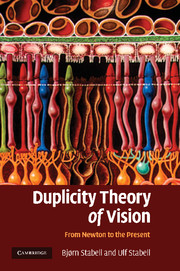Book contents
- Frontmatter
- Contents
- Acknowledgements
- 1 Introduction
- Part I The development of the basic ideas of the duplicity theory from Newton to G. E. Müller
- Part II The development of the duplicity theory from 1930–1966
- Part III Chromatic rod vision: a historical account
- Part IV Theories of sensitivity regulation of the rod and cone systems: a historical account
- 15 Introduction
- 16 Early photochemical explanations
- 17 Contribution of S. Hecht
- 18 Contribution of G. Wald: photochemical sensitivity regulation mechanisms of rods and cones
- 19 Relationship between amount of rhodopsin and sensitivity during dark adaptation
- 20 Post-receptor sensitivity regulation mechanisms
- 21 Rushton's AGC model
- 22 Contribution of H.B. Barlow
- 23 Rushton and Barlow compared
- 24 The Dowling-Rushton equation refuted
- 25 Several mechanisms involved in sensitivity regulation
- 26 Sensitivity regulation due to rod-cone interaction
- 27 Modern conceptions of sensitivity regulation
- Part V Factors that triggered the paradigm shifts in the development of the duplicity theory
- References
- Index
24 - The Dowling-Rushton equation refuted
Published online by Cambridge University Press: 22 January 2010
- Frontmatter
- Contents
- Acknowledgements
- 1 Introduction
- Part I The development of the basic ideas of the duplicity theory from Newton to G. E. Müller
- Part II The development of the duplicity theory from 1930–1966
- Part III Chromatic rod vision: a historical account
- Part IV Theories of sensitivity regulation of the rod and cone systems: a historical account
- 15 Introduction
- 16 Early photochemical explanations
- 17 Contribution of S. Hecht
- 18 Contribution of G. Wald: photochemical sensitivity regulation mechanisms of rods and cones
- 19 Relationship between amount of rhodopsin and sensitivity during dark adaptation
- 20 Post-receptor sensitivity regulation mechanisms
- 21 Rushton's AGC model
- 22 Contribution of H.B. Barlow
- 23 Rushton and Barlow compared
- 24 The Dowling-Rushton equation refuted
- 25 Several mechanisms involved in sensitivity regulation
- 26 Sensitivity regulation due to rod-cone interaction
- 27 Modern conceptions of sensitivity regulation
- Part V Factors that triggered the paradigm shifts in the development of the duplicity theory
- References
- Index
Summary
CONTRIBUTION OF T.D. LAMB
The theories of Rushton and Barlow were very much alive in the 1960s and 1970s and dominated the discussion about visual adaptation. The most convincing defence of Barlow's view was published by Lamb (1981). He admitted that Rushton's theory had received stronger support from the scientific community, but argued that Barlow's theory could more easily be reconciled with known properties of the visual system. He supported his view by presenting three strong arguments against Rushton's theory: (1) intracellular electrical recording from rods and cones under conditions of light adaptation had shown that photoreceptors could become desensitized in a way approximating the Weber law, (2) Rushton's theory implied that the photoreceptor could generate two quite different signals: an incident light intensity signal and a signal of the fraction of bleached photopigment, but no distinguishing mechanism located in the receptor had been found, and (3) the uniform desensitizing effect found by Rushton and Westheimer (1962) and Rushton (1965a) could not be repeated in an experiment performed by Barlow and Andrews (1973). In fact, these authors found a marked difference between sensitivity in the dark and bleached areas.
Lamb (1981) then went on to propose his own specification of Barlow's theory. By analyzing a series of rod dark-adaptation curves of a trichromat previously published by Pugh (1975), he came to the conclusion that the long-term dark-adaptation curve of rods could best be described by three straight lines, each with a different slope.
- Type
- Chapter
- Information
- Duplicity Theory of VisionFrom Newton to the Present, pp. 175 - 185Publisher: Cambridge University PressPrint publication year: 2009



